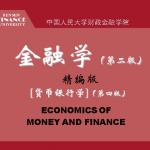广外 货币银行学期末重点 全英 米什金(3)
本站小编 免费考研网/2020-01-01
l Stresses transparency and accountability
l Disadvantages
l Delayed signaling
l Too much rigidity
l Potential for increased output fluctuations
l Low economic growth during disinflation
4.Monetary Policy with an Implicit Nominal Anchor
There is no explicit nominal anchor in the form of an overriding concern for the Fed.
Forward looking behavior and periodic “preemptive strikes”
The goal is to prevent inflation from getting started.
l Advantages
l Uses many sources of information
l Avoids time-inconsistency problem
l Disadvantages
l Lack of transparency and accountability
l Strong dependence on the preferences, skills, and trustworthiness of individuals in charge
l Inconsistent with democratic principles
5. Tactics: Choosing the Policy Instrument
l Tools
l Open market operation
l Reserve requirements
l Discount rate
l Policy instrument (operating instrument)
l Reserve aggregates
l Interest rates
l May be linked to an intermediate target
l Interest-rate and aggregate targets are incompatible (must chose one or the other).
6.Linkages Between Central Bank Tools, Policy Instruments, Intermediate Targets, and Goals of Monetary Policy(中间目标是超级重点,死活都要背下来)
Chapter19:The Demand for Money
1. Velocity of Money and The Equation of Exchange
V=P*Y/M
M*V=P*Y
2.Quantity Theory of Money Demand
SO: Demand for money is determined by:
The level of transactions generated by the level of nominal income PY
The institutions in the economy that affect the way people conduct transactions and thus determine velocity and hence k
3.Keynes’s Liquidity Preference Theory
Transactions motive
Precautionary motive
Speculative motive
Velocity is not constant:
4. Friedman’s Modern Quantity Theory of Money(记住该公式及其含义)
5. Differences between Keynes’s and Friedman’s Model (cont’d)
l Friedman
l Includes alternative assets to money
l Viewed money and goods as substitutes
l The expected return on money is not constant; however, rb – rm does stay constant as interest rates rise
l Interest rates have little effect on the demand for money
l Friedman (cont’d)
l The demand for money is stable ?
l velocity is predictable
l Money is the primary determinant of aggregate spending
Chapter23:Transmission Mechanisms of Monetary Policy: The Evidence
1.Framework
(1)Structural Model
whether one variable affects another
l Transmission mechanism
l The change in the money supply affects interest rates
l Interest rates affect investment spending
l Investment spending is a component of aggregate spending (output)
Advantages and Disadvantages
(2)Reduced-Form
l Analyzes the effect of changes in money supply on aggregate output (spending) to see if there is a high correlation
Advantages and Disadvantages
2. Transmission Mechanisms of Monetary Policy
(1) Asset Price Effects
Traditional interest rate effects
Exchange rate effects on net exports
...
(2)Credit View
Chapter24: Money and Inflation
1.meaning of inflation(死活背下来)
extremely high for a sustained period of time, its rate of money supply growth is also extremely high
l Money Growth
l High money growth produces high inflation
l Fiscal Policy
l Persistent high inflation cannot be driven by fiscal policy alone
l Supply Shocks
l Supply-side phenomena cannot be the source of persistent high inflation
l Conclusion: always a monetary phenomenon
2. Origins of Inflationary Monetary Policy
l Cost-push inflation
l Cannot occur without monetary authorities pursuing an accommodating policy
l Demand-pull inflation
l Budget deficits
l Can be the source only if the deficit is persistent and is financed by creating money rather than by issuing bonds
l Two underlying reasons
l Adherence of policymakers to a high employment target
l Presence of persistent government budget deficits
3. The Discretionary (Activist)/ Nondiscretionary (Nonactivist) Policy Debate
(1)Advocates of discretionary policy:
regard the self-correcting mechanism as slow
Policy lags slow activist policy
(2)Advocates of nondiscretionary policy:
believe government should not get involved
Discretionary policy produces volatility in both the price level and output
相关话题/货币银行学
金融硕士考研货币银行学复习方法
一、货币银行学框架货币银行学这门学科按字面的意思分为货币和银行两部分。现代的经济是货币经济,也就是说生产、分配、交换、消费必须依靠货币来进行。货币是基于人们对货币发行当局的信任而存在的,货币的出现为复杂的资源分配提供了一个简单的机制,即价格机制,通过价格决定每个人应该得到什么,应该生产什么,从而达到 ...金融硕士经验 本站小编 免费考研网 2019-12-12黄达金融学PPT课件精编版 货币银行学 第四版
 .. ...专业课考研资料 本站小编 免费考研网 2019-04-10
.. ...专业课考研资料 本站小编 免费考研网 2019-04-10四川大学货币银行学笔记
《货币银行学》概念缩略【川大版】 货币职能:交易职能、价值标准、延期支付、价值贮藏。 货币种类:实物货币(作为交易媒介的货币与商品价值量相等的货币)、信用货币(其本身 价值不与商品价值相等,但是其不能代表任何商品价值的货币)。 实物货币种类:实体货币、代表实物货币或者代用货币。前者是指,作为交易媒介 ...专业课考研资料 本站小编 免费考研网 2019-04-07对外经贸大学货币银行学作业、习题及答案
一、作业与习题 第一章 货币与货币制度 【作业与练习】 1. 基本概念:价值尺度 流通手段 支付手段 贮藏手段 铸币 信用货币 纸币 银行券 本位币 无限法偿 有限法偿 准货币 2. 试述货币的定义。 3. 比较货币职能的不同表述。 4. 试论货币在当代发达的市场经济条件下的作用。 5. 试述货币制度的基本构成要素。 6. ...专业课考研资料 本站小编 免费考研网 2019-04-05对外经贸大学货币银行学笔记
对外经贸大学货币银行学笔记 第一章货币的起源、本质和职能 一、 起源 货币产生于商品交换发展 为什么商品交换发展必定会产生货币 ①作为商品,具有使用价值和价值,两者密切结合,系于商品本身直接物物交换的特点。 ②货币的产生解决了直接物物交换的困难,整个商品流通由货币组成了一个链条。 不能解决私有 ...专业课考研资料 本站小编 免费考研网 2019-03-28西南财经大学货币银行学笔记
货币银行学笔记货币银行学:①含义;②研究的核心货币;③货币银行学的局限性:没能很好地把货币银行与金融市场联系起来。 货币与货币制度问题:(1)、是否作为交换媒介的商品就是货币?为什么?(是的,货币的演进)。(2)、货币是一般等价物,其内涵是什么?(货币是商品,有价值,商品充当交易媒介) ...专业课考研资料 本站小编 免费考研网 2019-03-27货币银行学学习笔记
《货币银行学》学习笔记 一、货币 1.信用货币、电子货币、0M、1M、2M、准货币 信用货币是货币的较高发展形式,它是指作为货币的价值大于其作为商品的价值的货币。它替代金属货币,在商品经济中充当流通手段和支付手段。①货币执行流通手段职能时,只在买卖瞬间起作用,人们只关心其购买力,并不关心货币本身有无价值,所以 ...专业课考研资料 本站小编 免费考研网 2019-03-25四川大学货币银行学考研复习笔记
《货币银行学》概念缩略【川大版】 货币职能:交易职能、价值标准、延期支付、价值贮藏。 货币种类:实物货币(作为交易媒介的货币与商品价值量相等的货币)、信用货币(其本身价值不与商品价值相等,但是其不能代表任何商品价值的货币)。 实物货币种类:实体货币、代表实物货币或者代用货币。前者是指,作为交易媒介 ...专业课考研资料 本站小编 免费考研网 2019-03-17金融-备考笔记-货币银行学-胡庆康
金融联考备考笔记-货币银行学 之三:货币银行学 注意:下文提及的结构与图表来自复旦出版社出版的《货币银行学》胡庆康编写 这本书是指定参考书 货币银行学和国际金融学不同于西方经济学,总的来说难度要小的多,没有复杂的模型和数学推导,而且其考试的特点是只会出现名词解释、计算题(简单的套公式和加减乘除)、 ...专业课考研资料 本站小编 免费考研网 2019-03-172018西北师范大学货币银行学考研金融复试复习题答案
 货币与货币制度 一、填空 1、从货币本质出发,货币是固定充当(一般等价物)的特殊商品;从价值规律的角度看,货币是核算(一般等价物)的工具。 2、古今中外很多思想家和经济学家都看到了货币的起源与(交换发展)的联系。 3、银行券是随 ...专业课考研资料 本站小编 免费考研网 2018-03-29
货币与货币制度 一、填空 1、从货币本质出发,货币是固定充当(一般等价物)的特殊商品;从价值规律的角度看,货币是核算(一般等价物)的工具。 2、古今中外很多思想家和经济学家都看到了货币的起源与(交换发展)的联系。 3、银行券是随 ...专业课考研资料 本站小编 免费考研网 2018-03-29西南大学2006年考研真题-货币银行学
专业课考研经验 本站小编 FreeKaoyan 2018-01-23河北大学2005年考研真题-货币银行学
专业课考研经验 本站小编 FreeKaoyan 2018-01-23中国人民银行研究生部2000年考研真题-货币银行学综合
一、简答题(每题5分,共50分)1.特别提款权2.自然失业率3.普惠制4.互助基金(MUTUALFUND)5.税收的特征6.完全市场竞争7.要约与要约邀请8.保险价值与保险金额9.二板市场10.国内生产总值平减指数与消费物价指数 二、简述题(每题10分,共50分)1.影响需求弹性的因素有哪些?2. ...专业课考研经验 本站小编 FreeKaoyan 2018-01-22中国人民银行研究生部2001年考研真题-货币银行学综合
一、简答题(每题5分,共50分): 1、效用 2、局部均衡和一般均衡 3、购买力平价 4、替代与互补 5、财政的经济职能 6、再保险 7、国际金融市场是由哪几个子市场构成的 8、借款合同的概念及其主要条款 9、什么是货币的贮藏手段 10、什么是商业汇票 二、简述题(每题10分,共50分): 1、解释 ...专业课考研经验 本站小编 FreeKaoyan 2018-01-22中国人民银行研究生部2000年考研真题-货币银行学
一、简答(每题5分,共40分)l、货币交上有过哪几种主要的货币本位制?2、怎样衡量金融资产的流动性?3、商业银行分业经营的主要内容是什么?4、其它条件一定,假定某上市公司股票下一年的预期收益是每股0.5,市场利率为5%,其理论股价应是多少?若市场利率降至4%,理论股价又应为多少?5、国际收支表中,资 ...专业课考研经验 本站小编 FreeKaoyan 2018-01-22
